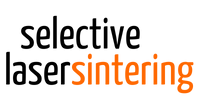![]() Each 3D printing process brings with it specific properties that make it more suitable for manufacturing certain objects than others. The choice of technology should therefore be made depending on the physical properties of the planned component.
Each 3D printing process brings with it specific properties that make it more suitable for manufacturing certain objects than others. The choice of technology should therefore be made depending on the physical properties of the planned component.
![]() Here you can learn more about the SLS process.
Here you can learn more about the SLS process.
Advantages of selective laser sintering (SLS)
Design freedom
The greatest advantage of selective laser sintering is the production of components without additional support structures or materials that would have to be manually removed afterwards. Functional assemblies with overhangs or internal structures, such as cooling channels, can be produced in one piece without intermediate steps.
Wide range of materials
In the meantime, a large number of basic materials and material mixtures are available for selective laser sintering, which are also constantly being further developed. While mainly acrylic or epoxy-based resins are used in stereolithography, various polymers from the polyamide family are used in selective laser sintering. These are characterized by their dimensional and temperature stability and are also mechanically resilient and insensitive to many chemicals. Objects made of epoxy resin break more easily than laser-sintered components. The latter exhibit high flexibility with thin wall thicknesses and great strength with increasing wall thickness. Food-safe fabrications are also possible. Thanks to these properties, sintered fabrications can be used in a wide range of applications, for example in the medical, automotive or aerospace industries.
Calculable costs
Unlike ablative processes (e.g. milling, turning, grinding), SLS only incurs costs due to the size of the component, not its complexity. Due to the tool-less production based on CAD data, each component goes through the same production process. Costs vary depending on the type and quantity of the base material and subsequent finishing. In comparison, polyamide mixtures are significantly cheaper than the epoxy resins used in stereolithography.
Economical in material consumption
Powder that has not been fused is extracted at the end of the manufacturing process. It is then sieved so that a large part can be reintroduced into production.
Limitations of selective laser sintering (SLS)
Surface structure
Due to the size of the powder grain, the surface of laser-sintered components is slightly rough and allows only medium detail resolution. This can be remedied by fine grinding and polishing during finishing.
Colorfulness/Transparency
In contrast to stereolithography, transparent structures cannot be produced due to the material, and only monochrome objects are possible due to the powder bath construction method. Untreated components also tend to discolor. As a finishing touch, however, the fabrications can be painted or dipped in RAL colors.





